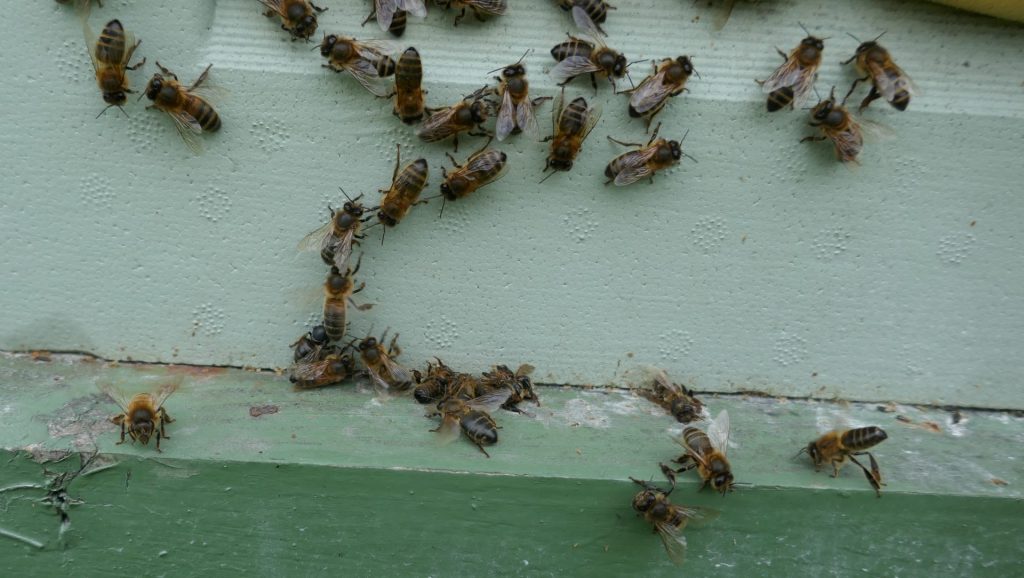
Equinoctial gales herald the changes to autumn as the last super of the honey is being taken off and the active beekeeping season draws to an end here. All 12 colonies have a super of honey each for winter stores and I’m up to my ears in honey processing. This is one of the best years for honey production in my beekeeping career.
The last fortnight has been busy and I’m reminded of it when I discover a minature pork pie in my handbag as I rummage for a mask before entering The Cawdor Tavern the other evening. Luckily it hasn’t gone off yet after a week, or disintegrated, and I make a mental note to clean my handbag out soon and chuck it. Last week I was rushing down to Forres after food shopping to help Gelda check on her colony that we united due to her queen disappearing without trace, and a hopelessly queenless situation.
I’d bought a packet of tiny pork pies for a quick lunch in the car while waiting to pick up Gelda and one must have escaped as I heaved the bag into the back seat when Gelda arrived in her bee suit all ready for the job. She keeps one colony of bees on a Findhorn Foundation property which was once a luxury Victorian holiday hotel on the outskirts of the town of Forres. It is surrounded by amazingly tall mostly native trees though is seems strange having monkey puzzles next to birch trees somehow.
The colony is situated on a terrace overlooking a golf course in the distance and the immediate surroundings are full of pollinator friendly flowers. The lavender was switching with bumble bees even though it was at the end of blooming. Luckily for Gelda our friend Rick came to the rescue and let her have one of his surplus-to-requirement colonies to unite with hers and that went very well. In the fortnight since their arrival they had filled a super for winter stores and the newspaper was well and truly chewed up. This situation illustrates the need to have at least 2 colonies to be self sufficient in beekeeping when a queen is lost.
Strange Behaviour at Home.
Hive 11 attracted my attention a couple of weeks ago by some very strange behaviour that needed further investigation. The now very strong colony was collected as a swarm from Brackla Distillery mid-July when things looked promising. However, because it was collected at dusk at the end of a long busy day I didn’t take it to the quarantine apiary.
It built up very quickly but I’d run out of brood boxes so kept it in a single box in with 2 honey supers which it filled. Then the odd behaviour. I first noticed a virgin queen on the outside of the brood box. She looked reluctant to be outside and kept going back in then presumably was pushed out again. I figured she was reluctant to go on a mating flight.
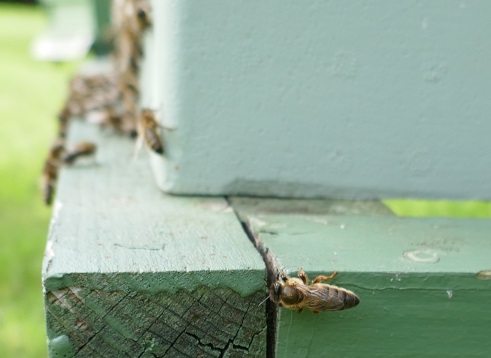
The bees stopped foraging and were milling about outside the hive on the front of the brood box. I checked to see if any were washboarding but they weren’t, rather they were running about in an agitated state that looked like robbing at first since bees were being dragged outside. Some of them looked like they were shivvering.
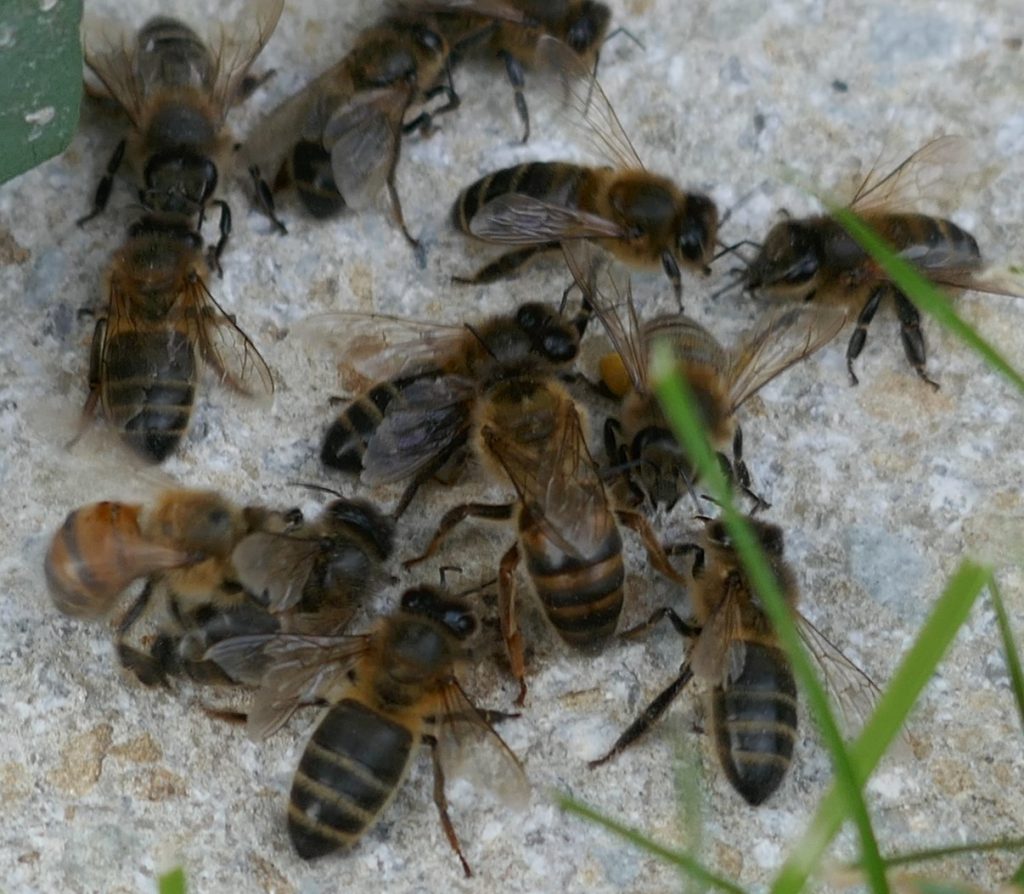
Later in the day the queen was outside on the floor with her front legs on a worker’s body so I investigated inside. It was still warm in early evening and what I found was a suprise. Having first thought that the virgin queen was the result of supersedure, I found at least 10 emergency swarm cells all at the stage of queen emergence with some emerging as I held the frames. The bees were running in an agitated way as if on a treadmill and I noticed many with dark shiny abdomens.
Overnight it rained heavily and next day too. When it stopped I noticed a carpet of dead and crawling bees out front and realised that the colony must have CBPV and that I needed to destroy them before they infected the rest of the apiary.
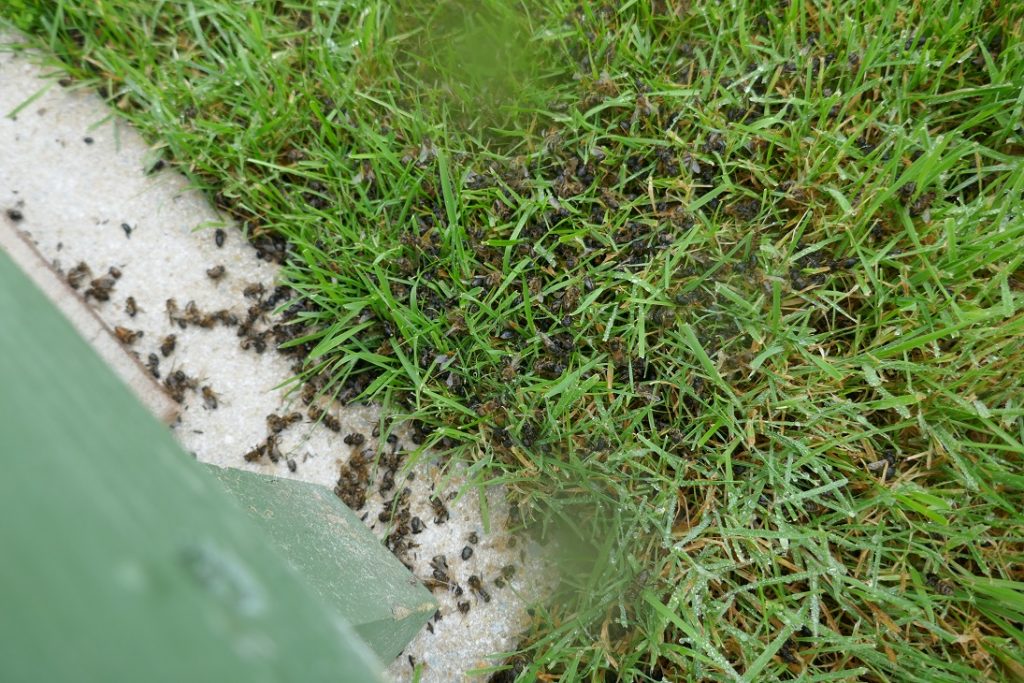
I moved the colony onto very old brood frames because I wanted to thoroughly examine the ones they had been on before destroying them. I removed the honey super. I’d run out of wooden hive bodies so I used the oldest 12″x14″ poly hive I no longer operate which is risky since petrol eats up plastic and you must use wooden hives for this procedure. I sealed the open mesh floor with a heavy duty plastic bag. Before it got dark, I poured 1/4 pint of petrol in through the crown board. There was a chilling roar from the bees that lasted seconds thankfully, and I walked away with a heavy heart. In the morning, the petrol fumes had dissipated and I removed the dead bees and burnt them along with all the brood frames. I found that the original swarm queen must have died some weeks ago since there were no eggs or larvae and only sealed worker cells full of chalkbrood.
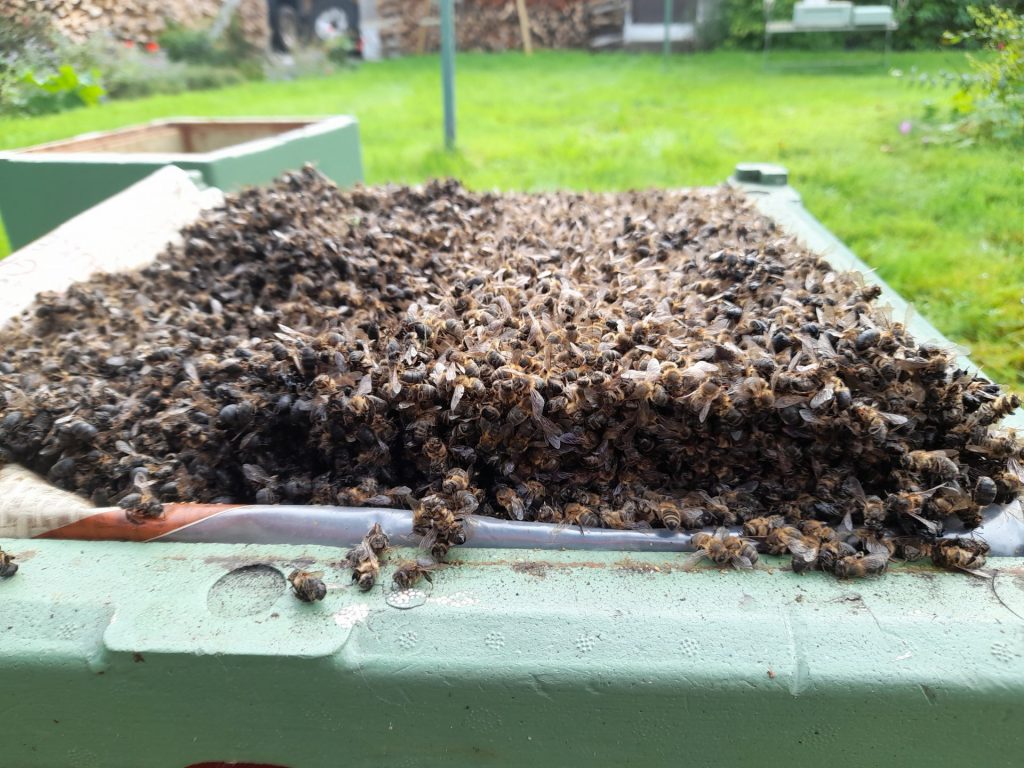
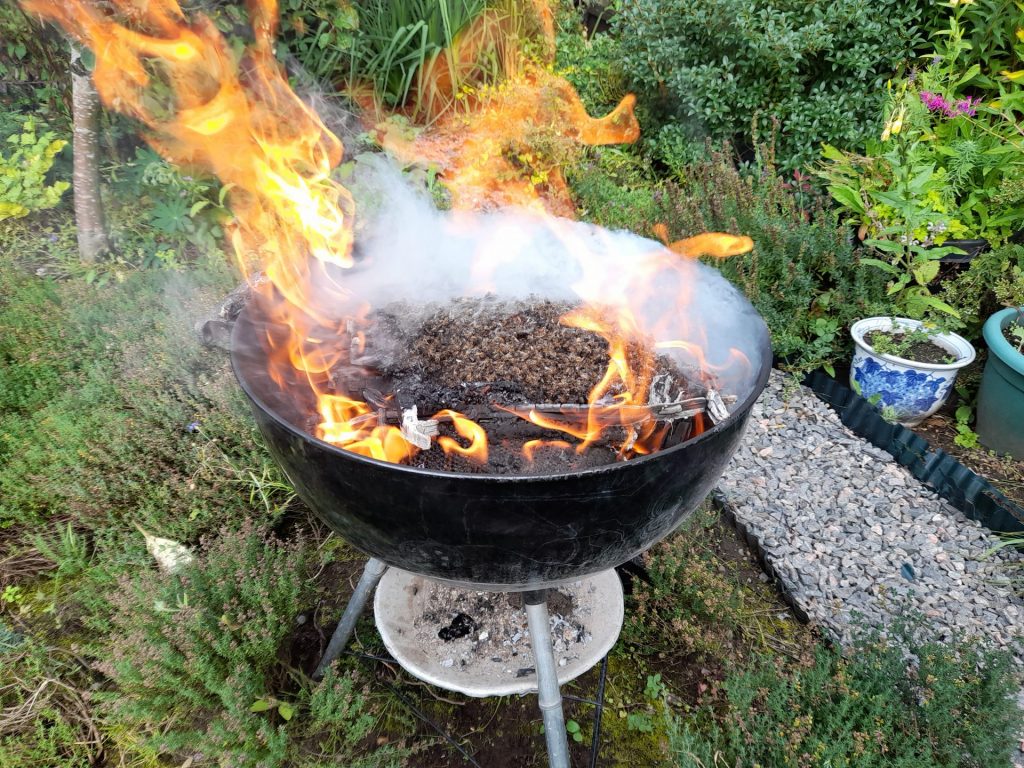
I emailed all the local beekeepers who might have lost that swarm in July so that they can be vigilant in their apiaries.
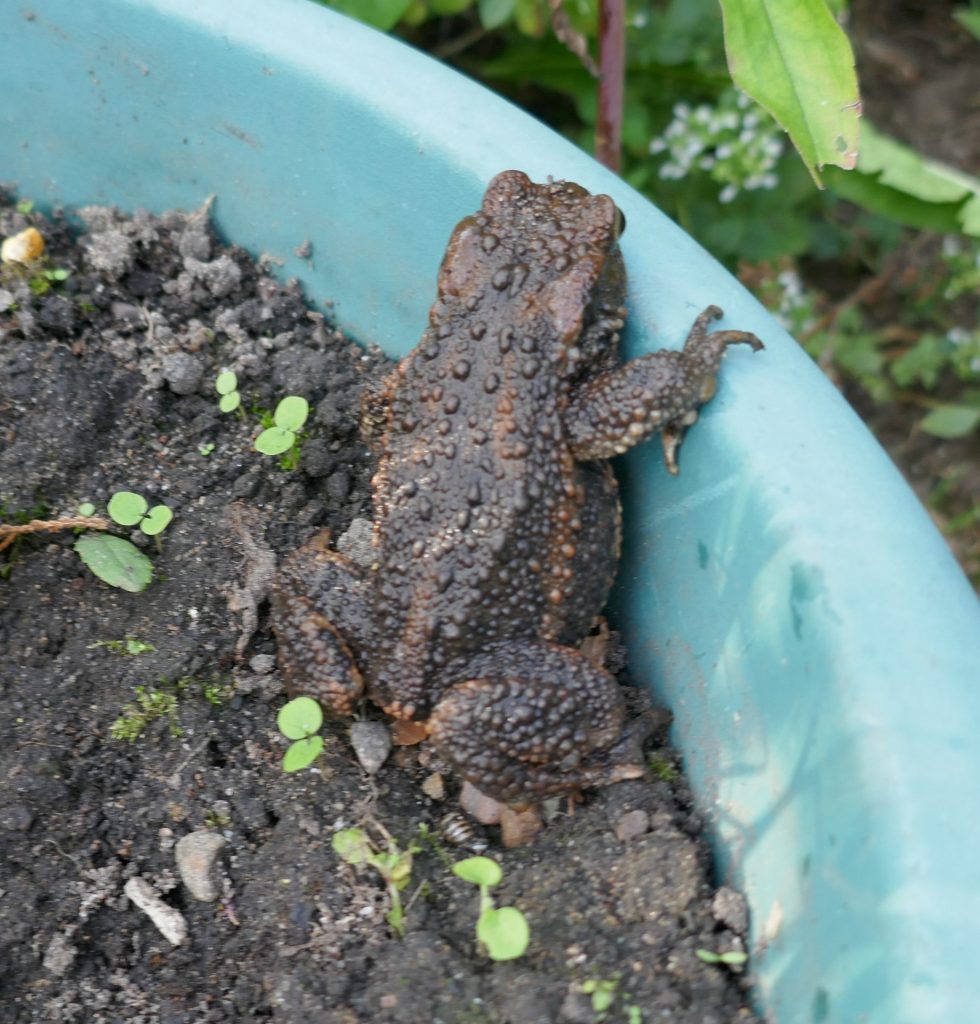
Side-Tracked by a Handsome Toad.
During all the kerfuffle of photographing and worrying about the colony, I found a toad swimming in the deep sided water butt and got distracted rescuing him. Since it was clear he wasn’t going to get out again by himself I placed my camera on the compost bin to lift out toad and make a wooden ladder in the water butt in case he returned. Needless to say it rained again between this event and discovering the “lost” camera. At the moment the camera is in a plastic bag of rice grains in the hopes of it drying out.
Next week I’ll report on the honey harvest and the famous Ross rounds mentioned in a previous blog, and with much luck may be able to photograph them!

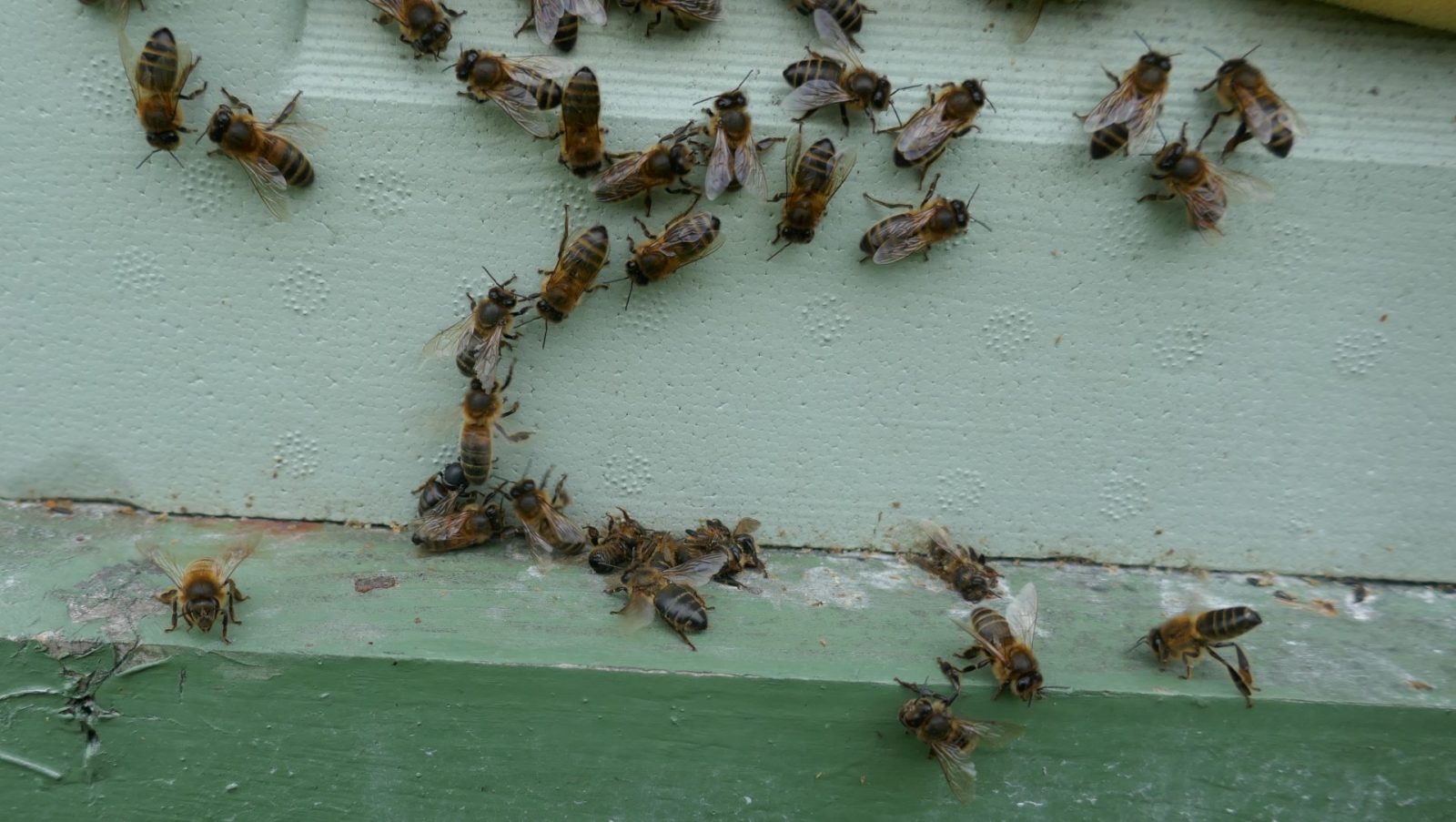
Have you discovered yet what the swarm’s origin was?
I.e. was the original mother colony imported from another area or local? Any clues from colouring?
Did you freeze any bees for later examination?
I picked up a “swarm” late August in a field in the middle of nowhere. It is almost certainly a colony that absconded due to some pressure. Google Earth showed me what looked like 7 hives in a village back garden 500m away, there were no other obvious sources. I put it in an isolated hive and am keeping a really close eye on this one, much closer than I would with a real swarm from a survivor colony. Swarms are normally firebreaks vs disease, especially if you don’t feed them to ensure they digest all spores etc in the honey they flew off with.
You’re probably aware of Budge’s analysis of CBPV being correlated to imported bees (“Chronic Bee Paralysis as a serious emerging threat to honey bees”)
Hello Paul, Thank you for commenting. I think that the colony was very local and not imported from another area but I doubt I shall ever know from which apiary it came. All local beekeepers I know of have been told about it. The bees were the same colour (fairly dark) as all the swarms I’ve seen have been this year in my area.
I am aware of Budge’s work and thankfully it is ongoing and we should know more next summer according to Prof.David Evans with whom I have been in communications over this.
No, I didn’t keep samples but this is probably a good thing to do. I need to buy a bigger freezer as it is currently stuffed full of bags of plums and cut comb !!
Thank you, Ann, for describing in detail what you observed of the colony with the CBPV. This is a malady that I have not yet seen, so it is good to know what the symptoms are of an a colony infected with, and suffering from, this virus. It is good to know that the sick bees drag themselves outside and display their paralysis symptoms.
It’s good to know that you have not encountered it in your apiaries yet, Tom. It looks like it is on the increase here and linked to importation of queens.
Hi Ann – really useful insight, thank you. You talked about washboarding – “I checked to see if any were washboarding but they weren’t” – can you tell me why this was something to check? I’ve heard so many conflicting reasons as to why the bees do this, including that it is stress related – and I’ve witnessed it more that a couple of times in the last 3 years…can you help me understand what is going on?
Thanks
Liz
Hello Liz. I’ve never actually seen washboarding first hand so interesting that you have seen it several times. Apparently it is more often seen in the USA than here in the UK, and Tom Seeley says that in the wild it serves to clean the surfaces of decayed wood etc. It must be some evolutionary response.
There is an interesting photo on page 43 of October’s BeeCraft magazine showing a photo of the front of a poly hive where bees have been washboarding. You can see the lighter area where the surface was rubbed.
I was hoping that the odd behaviour on the front of that hive was nothing serious and I would have been so relieved to have seen washboarding.
Best wishes, Ann
KEEPING THE SWARM
Catching a swarm is the greater part of the fun; keeping it once you bring it home is another test.
A client sent in saying they wish they had to find out about how to catch and keep swarms, saying they have gotten a few swarms before yet had little accomplishment in holding them back from leaving. In the wake of calling us and talking with somebody here at Buzzing Bee, they were glad to report they were effective in keeping their next swarm.
What was the mysterious answer they have gotten? All things considered, we needed to make a few inquiries Buzzing Bee, however, this is the thing that we learned.
When catching swarms, they don’t generally remain where we put them. Try to get the swarm sovereign laying, and your odds of them waiting for increment significantly.
At the point when I get a swarm, I put them into a crate and introduce a sovereign excluder under the case on top of the baseboard. This transforms the sovereign excluder into a sovereign includer. I additionally take a branch with leaves on it and push it before the hive so the honey bees need to fly through the leaves. This will get them to arrange to the hive. I think it is the actual demonstration of creeping through the leaves and branches that gets the job done. Putting them on the drawn brush, as well as brush with stores in them will likewise help. When the sovereign has started to lay, you can eliminate the excluder and the branch. Ensure you have the passage stopped up.
Good luck with your next swarm!
https://www.beekeeper-suit.com/
Hello James. Interesting response to the CBPV blog hearing how you keep swarms from leaving. Thank you for the tips. If you are seeking to promote your own business via the Beelistener blog I would consider publishing a guest blog. Best wishes, Ann.
we are not promoting but we would like to do a guest blog.
Thank you, James. We would love to hear from you. Best wishes, Ann.
I found this blog post on “The Swarm With CBPV” to be quite informative and intriguing. The concept of utilizing CBPV (Chronic Bee Paralysis Virus) in relation to swarm behavior in bees is fascinating. It’s clear that the author has a deep understanding of bee biology and the intricate factors that contribute to swarming.
I appreciate how the post delves into the role of CBPV in the swarming process, shedding light on its potential impact on honeybee colonies. The author’s ability to convey complex scientific information in an accessible manner is commendable.
Furthermore, the blog post raises important questions about the implications of CBPV on bee populations and, by extension, our ecosystem. It serves as a reminder of the interconnectedness of all species on our planet and highlights the significance of understanding the dynamics that drive bee behavior.
Overall, a well-written and thought-provoking article that encourages readers to ponder the intricate relationship between honeybees, viruses, and swarming behavior. I look forward to reading more from this author on this intriguing subject.
Good luck with your next swarm!
https://ozarmour.co/en-eu
Hello, David. Welcome to the Beelistener as a regular reader, and thank you for your positive comments. I’m glad that my article interested you and was useful. Preparing articles like this involves a lot of research and cross referencing so I cannot come up with them every week but I try to engage the readers and share something to help with some aspect of beekeeping to ultimately make things better for the bees.
You will be having your own challenges as Australia comes to terms with the arrival of varroa and learning how to reduce the risks and manage it, on top of another hot summer. Best wishes, Ann.